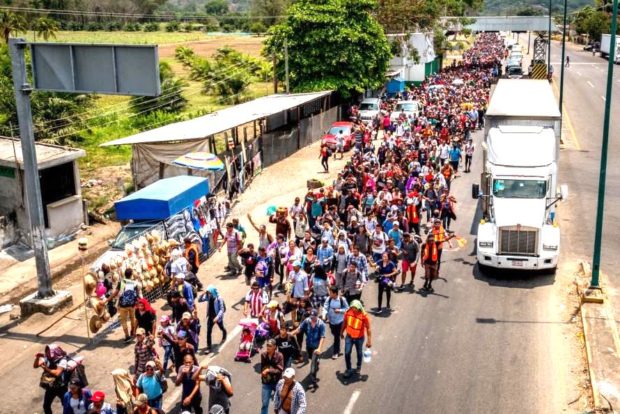
Migrants heading for the U.S. – Mexico border.
NEW YORK—As the saying goes, “We are here because you were there.”
That the caravan of Central Americans is now at the southern border, in and around Tijuana, Mexico, is an indication that the chickens have come home to roost. Given the long history of United States interference—sometimes openly invading, often not—in the affairs of Central American governments, there is poetic justice in their citizens now seeking asylum in the U.S. and fleeing the violence and economic instability, caused in large part by those very same U.S. interventions.
In 1904, President Theodore Roosevelt laid out policies that essentially treated Latin America as its “backyard,” with the U.S. as the region’s self-appointed policeman. This is the same Roosevelt that pushed for the 1898 Spanish-American War, thus paving the way for the U.S. to become involved in Cuba, take over Puerto Rico, Guam, and with the 1899 Philippine-American War, colonize the Philippines.
With the advent of the Cold War, the U.S. didn’t hesitate to step in and instigate coups, help rig elections, back right-wing strongmen or even send in U.S. troops to oust a reform-minded, left-wing government supposedly to defend the “Free World” from the threat of Communism. In reality, it was to maintain the subordinate status of client states as well as the cozy and financially rewarding relationships among U.S. agribusiness, military cabals, and opportunistic politicians.
The list of U.S. meddling in Latin America is long and provides a much-needed context (though not all of it) to the current immigration mess. Here are just a few instances of Washington’s heavy hand:
- Cuba: In 1961, a U.S.-backed force of 1,400 anti-Castro Cubans, lands at Cuba’s Bay of Pigs, where the adventurers are handily defeated by the Cubans. (Interestingly, one of the group’s military trainer/advisers was Col. Napoleon Valeriano, a Filipino officer who, with the CIA’s Col. Edward Lansdale, helped break the back of the 1950s Communist Huk insurgency in the Philippines that sought to overthrow the Philippine government, distance itself from the United States, and establish a socialist state.)
- Guatemala: Having helped depose reform-minded Jacobo Arbenz Guzmán, elected president of Guatemala, who had introduced much needed land reform in the 1950s, beginning the next decade, U.S. Green Berets train the Guatemalanarmy in counterinsurgency techniques. These techniques included aerial bombings, putting to the torch towns thought to aid the rebels, and the use of death squads, believed to have resulted in 20,000 people being disappeared between 1966 and 1976.
- Nicaragua: In the 1980s, disturbed by the ouster of U.S.-backed dictator Anastasio Somoza by the Sandinistas, the U.S. funds and organizes the Contrasin Nicaragua. By 1985 the Contras number about 12,000. Washington imposes an economic embargo of the country and using its influence, gets the IMF and the World Bank to limit or altogether halt loans to Nicaragua. In an illegal deal, the U.S. sells arms to Iran, with which the U.S. has broken diplomatic relations, in order to funnel the money raised to the Contras. The U.S. sees to it that the Contras base themselves in nearby U.S.-friendly Honduras, which has its own death squads.
- Chile: In 1973, aU.S.-supported military coup kills democratically elected Salvador Allende and General Augusto Pinochet takes over. Pinochet wastes no time: civil liberties are suspended, unions are abolished, Allende’s land reform measures reversed, and over a hundred thousand Chileans are imprisoned—many of them tortured and raped.
- Grenada: U.S. troops land in the tiny Caribbean nation of Granada in 1983, due apparently to the Cubans helping the government build an airport. President Reagan justifies the invasion by claiming the airport was a ruse for the Soviets to come in.
- Panama: The U.S. invades Panamain 1989 to capture dictator Manuel Noriega, once a CIA protégé, for drug dealings and money laundering. He helped the U.S. facilitate the Iran-Contra arrangement. By 1989 however Noriega was seen as a liability rather than an asset.
The fanciful notion that a whole region was the backyard of the United States can be said to have encompassed the whole world, its main rival being the USSR. From the Middle East to Africa, from the Caribbean to Southeast Asia—most tellingly in Vietnam—the foreign policy of the United States proved to be a consistently disruptive force. The dictatorial regime of Ferdinand Marcos had the support of successive U.S. presidents, from Lyndon B. Johnson to Ronald Reagan.
If the Republic of the Philippines shared a border with the United States of America, you can bet that among the migrants clustered around the land border would be Filipinos desperate for a better tomorrow.
Copyright L.H. Francia 2018

